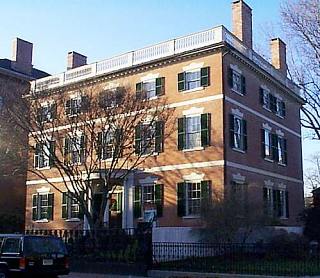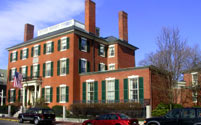The new home of the Bertram Home for Aged Men at 29 Washington Square had been built for John Forrester in 1818-19. The brick Federal mansion was acquired in 1834 by George Peabody, a successful merchant and accomplished musician.
Peabody lived in the house for nearly 60 years. and added the one-story dining room. Here he entertained Henry Wadsworth Longfellow, the Swiss naturalist Louis Aggasiz, and many other notable 19th century personages.
For the first quarter of the 20th century, before it was purchased by the Bertram Home for Aged Men (now known as the Bertram Home), the Washington Square mansion was occupied by the Salem Club. This private men’s club featured a dining room, a billiard room, and a full schedule of social, cultural, and educational programs.
Just opposite the Salem Common from the Bertram Home, at 94 Washington Square, stands the former mansion of merchant-statesman Nathaniel Silsbee. The residence was built in 1818-9 and was a private residence until 1906 when it was acquired by the Knights of Columbus.
Another federal-style mansion, at 180 Derby Street, now houses the Brookehouse for Women. The massive brick home was built for Benjamin Crowninshield (1775-1851) between 1810 and 1812 and may have been designed by Salem’s famed architect-woodcarver, Samuel McIntire.
Crowninshield made his fortune in the East India trade and served as secretary of the navy under Presidents Madison and Monroe. The latter stayed in Crowninshield’s waterfront mansion during his visit to Salem in 1817.
William Crowninshield Endicott, who would later serve as a member of the Massachusetts Supreme Judicial Court and secretary of war under President Cleveland, was born in this house in 1826. General James Miller, the hero of the Battle of Lundy’s Lane in New York in the War of 1812, lived here from 1825 until his death in 1851.
For most of those years Miller served as collector at the nearby Custom House.
In 1861 the mansion was purchased by another Salem merchant, Robert Brookehouse, who then donated it to what was at the time called the Association for the Relief of Aged and Destitute Women. The building was subsequently enlarged and today serves a residence for retired women.
The headquarters of the Children’s Friend and Family Service Society of the North Shore, Inc. at 48 Bridge Street was also built as a private residence during Salem’s East India trade era. The substantial brick home, whose design has been attributed to Samuel McIntire by architectural historian Fiske Kimball, was erected for leather factory owner Thomas Woodbridge in 1809-10. It was briefly owned by the Society for the Preservation of New England Antiquities in the 1940s and acquired by its current owners in 1955.
Jim McAllister
All rights reserved



